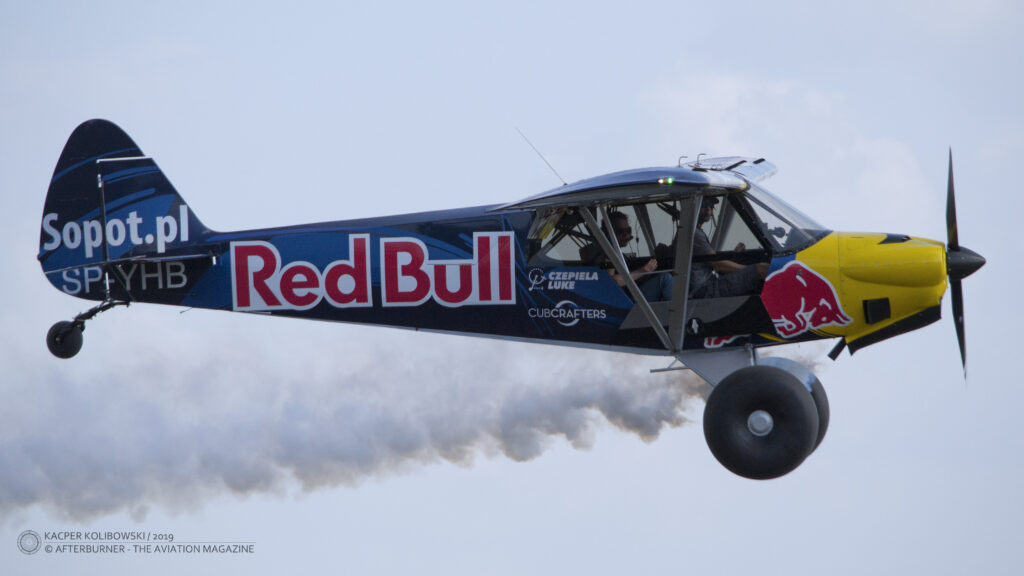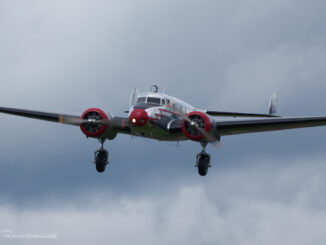 CubCrafters CC11-160 Carbon Cub EX (SP-YHB, c/n CCK-1865-0116), Kruszyn Aerodrome (Aeroclub of Włocławek), 25th April 2019.
CubCrafters CC11-160 Carbon Cub EX (SP-YHB, c/n CCK-1865-0116), Kruszyn Aerodrome (Aeroclub of Włocławek), 25th April 2019.
Carbon Cub is an aeroplane with superb flying capabilities, that may definitely be called a truly 21st century incarnation of the legendary Piper Cub and Super Cub aircraft. However, it is worth to start by telling its story from the very beginning.
In 1980, Jim Richmond, then owner of a home insulation company, took a trip to Alaska. And it was the exact moment when he was impressed by Piper PA-18 Super Cub aircraft – at that time, the most popular bush aeroplane in the region. In result, Richmond decided to sell his existing business and, shortly thereafter, founded an enterprise named Cub Crafters, Inc.
His company, with a seat in Yakima, Washington, started out its activity just by rebuilding and modifying the above mentioned Super Cub aeroplanes. However, Jim Richmond, as an experienced innovative engineer and accomplished aviation mechanic, was convinced that the Super Cub still had some untapped potential.
In the next twenty years, Richmond – along with a group of like-minded specialists he had gathered over that time – was searching for a way to improve the Super Cub airframe and enhance its performance and capabilities. Finally, those efforts had resulted in a series of aircraft developed by CubCrafters company. Although still being based on the PA-18 design, those aeroplanes were significantly improved, essentially by extensive use of carbon fibre composites in their construction. And thus Richmond´s company became a full-fledged aircraft manufacturer.
An aeroplane designated CubCrafters CC18-180 Top Cub, developed in the early 2000s, was the first of the new generation aircraft developed by the company that entered the market as the direct Super Cub successor. Already in 2004, the CC18-180 Top Cub received the FAA certification and four years later, the aeroplane was also certified in Canada and Australia.
Appearance of CC18-180 Top Cub on the market, caused a sensation in the aviation world and the aircraft quickly attracted a lot of interest worldwide. When, in 2004, a new category of Light Sport Aircraft (LSA) was introduced in the USA, Cub Crafters quickly responded with two more Cub-based aeroplanes that met technical requirements of that category.
The first of them was CubCrafters CC11-100 Sport Cub, developed and marketed just a year after introduction of the LSA category. Similarly as the previous CubCrafters design, also that aircraft was based on another classic Piper aeroplane design – the J-3 Cub. This time, however, powered by a more powerful 100hp Continental O-200 engine.
Another aircraft within the LSA category made by CubCrafters company was designated CC11-160 Carbon Cub SS. Although the overall appearance of its airframe resembles the Super Cub, the new aeroplane has been developed completely from scratch using the newest computer-aided design process. For Carbon Cub construction, carbon fibre composites and the latest technologies available in the light aircraft industry were used. The aircraft had an official public premiere in 2007, being exhibited at the Alaska State Aviation Trade Show and Conference in Valdez.
In following years, two more aeroplanes based on timeless design of Piper Cub aircraft family were introduced by CubCrafters. They are Carbon Cub FX and XCub/NXCub, respectively. A significant milestone for the company was achieved in 2015, when CubCrafters sold the type certificate of Top Cub aeroplane to Liaoning Cub Aircraft Corporation, which allowed the CC18-180 to enter the Chinese market.
Referring again to CubCrafters CC11-160 Carbon Cub SS, it should be noted that because of carbon fibre and chrome-molybdenum steel used in its construction the aircraft is commonly known as just ´Carbon Cub´. That, together with technologies used in its construction, created a fuselage of an exceptionally strong structure, at the same time reducing the weight and number of parts used. Moreover, the new aeroplane received a completely redesigned and more spacious cockpit.
The Carbon Cub is powered by a 180hp CubCrafters CC340 engine – being a modified, lighter and more powerful version of Lycoming O-320 – equipped with 2-bladed CATTO composite propeller.
With an engine of such power and a maximum gross weight of only 599 kilograms, the Carbon Cub has a simply excellent power-to-weight ratio and Short Take-Off and Landing (STOL) characteristics. And the aircraft proved it already during the previously mentioned Alaska State Aviation Trade Show and Conference 2007. In a then organised STOL competition, the Carbon Cub beat a record for the shortest take-off with a result of only 19 feet (less than 6 meters).
The canvas-covered wings of the CC11-160 are fitted with vortex generators to additionally improve its stability at lower speeds. That´s why the Carbon Cub is characterised by a very low stall speed – not only increasing safety of flying but also being an advantage when operating in difficult terrain. Additionally, the Carbon Cub can be equipped with larger Tundra-type tyres and floats.
The list of customised equipment includes a ´glass cockpit´ with the newest avionics systems, a larger fuel tank, strengthened landing gear suspension, enlarged baggage compartment, additional lighting or a steerable tailwheel. All the features mentioned above make the Carbon Club an excellent STOL and bush-flying aircraft.
Last but not least, it should be mentioned here that the CC11-160 is also available in a self-assembly version, designated as Carbon Cub EX.
And exactly such example is featured in the photo above – the CubCrafters CC11-160 Carbon Cub EX (c/n. CCK-1865-0116), registered SP-YHB. It is currently being flown by Łukasz Czepiela – Polish commercial and aerobatic pilot, two-time Red Bull Air Race World Champion in the Challenger Cup class (2018 and 2019).
The pilot and his aircraft made headlines in 2019. That year, exactly on 24th April, Łukasz Czepiela has landed the Carbon Cub SP-YHB on historic pier in Sopot, on the Polish Baltic coast. It was the very first landing of that kind ever. The purpose of that event was to inaugurate, in a very exceptional way, new summer season in Sopot, being one of the most popular Polish seaside cities.
A day after the historic landing on the Sopot pier, on the way back to their home airfield in Rudniki (Aeroclub of Częstochowa), Łukasz Czepiela and Carbon Cub SP-YHB made a stopover at Kruszyn airfield (Aeroclub of Włocławek). And that was exactly when our current Photo of the Week was taken.



